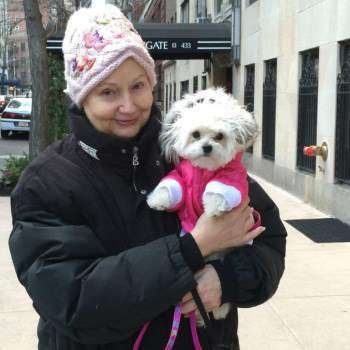Maltipoo Health Problems
Overview
Let’s first keep in mind that any dog, either purebred or mixed is prone to certain health issues….Just like humans. Not all health issues can be completely avoided….However; some can be prevented with proper care.
Some of the following Maltipoo health problems are due to the size of this dog….And are more common with any small breed dog, such as the Pomeranian, Chihuahua, Maltese, Pug, Toy Poodle and others. And let us remember that all dogs are able to become ill, the Maltipoo is no less healthy than any other dog.
Generally, this crossbred is a healthy dog with lots of energy and vigor….living an average of life expectancy of 15 years, which is considered to be a long life for a canine. You can read more about Maltipoo Age
here.
White Shaker Syndrome
As the name implies, this condition only occurs with white dogs. The Maltese is very prone to this, since the dog only is found with white coats. This is one reason why breeding white Maltipoos is tricky….They are sought after and a popular color choice, but when breeding a white Maltese and a white Poodle to produce white puppies, it also increases the risk of this health problem.
With this health issue, the dog will have tremors of their entire body. There are environmental conditions that can trigger this to happen as well as genetic causes. Episodes most often begin between the ages of 6 months old to 3 years old.
Collapsed Trachea
This Maltipoo health problem can be greatly prevented by proper care
by the owner! This is a sad and disturbing condition. A dog’s throat has rings of cartilage around it. Without proper care, one or more of these rings can collapse inward…making it very difficult for the dog to breath and causing pain.
Luxating Patella
Also known as Patellar Luxation. This is very common with small dog breeds. It is extremely common with the Chihuahua, and is common with the Pomeranian, Shih Tzu, Maltese and other tiny dogs, the Maltipoo is no exception. “Hyrid Vigor” as talked about above, does not decrease the chances of this. This is a condition that CAN be genetic, however in many cases, proper care can prevent this from happening!
Before buying a Maltipoo puppy, it is important to see that BOTH parents have health clearances from the Orthopedic Foundation for Animals for patellas (knees).
You should ask the breeder to see the paper work for this, this will mean that both parents were tested for this condition (which CAN be genetic) and both have passed, meaning that neither carries the genes that would cause a puppy to be prone to this.
Dental Problems
Tiny dogs may have tiny teeth, but this does not affect the heartbreaking conditions that can occur without proper dental care. Read More About Providing Proper Dental Care for Your Maltipoo Here
Progressive Retinal Atrophy (PRA)
This is a degenerative eye disorder that eventually causes blindness from the loss of photoreceptors at the back of the eye. PRA is detectable years before the dog shows any signs of blindness. Currently, there is no cure for this, but there are things that you can do to help.
Allergies
One of the reasons that the Maltipoo is such a popular crossbred is because most people who are allergic to dogs are not allergic to this dog. However, the Maltipoo itself can suffer from allergies and this can sometimes be very severe.
Hip Dysplasia - A Hip Problem
Hip Dysplasia is common with some dogs. This health problem can develop due to genetic disposition OR it can happen from injury. Therefore, proper care of the owner can help prevent this. This is a canine health condition in which the ball and socket of the dog's hip slip out of place. This can cause severe discomfort and an lack of ability to perform daily activities. Exercising...even walking can become tremendously difficult. Luckily, there is treatment for this and prognosis is good if caught early. Read More About Maltipoo Hip Dysplasia Here
Seizures & Epilepsy
A dog can get seizures, just like a human. There are different types such as the Tonic-clonic, Petit Mal or Status Epilepticus. If your pup is showing strange symptoms such as repeated behavior (as if a movie is looping over and over again), drooling, staring into space, a bewildered look, falling down, inflexible limbs or unconsciousness…learn about the different types of canine seizures, the symptoms of each and what to do if this happens.
Thyroid Problems – Hypothyroidism
A possible health problem is issues with the thyroid gland, actually not uncommon with all dog breeds. Problems with a thyroid gland can cause a distressing range of canine health issues. When a dog’s thyroid fails to regulate properly, it can cause problems that range from epilepsy to skin conditions.
Cardiomyopathy (Heart Condition)
This is not that common, but it IS something to be aware of. Maltipoo Cardiomyopathy is a very complicated Maltipoo health condition. Studies are still underway to understand more about this. Presently it is known that this health issue causes the heart of the dog to beat too rapidly or unsteadily. This can happen at random intervals and is sometimes difficult to be aware of unless you know what symptoms to look for.
Legg-Calve-Perthes Disease
Legg-Calve-Perthes Disease (LCP Disease) is a congenital (which means present at birth) degeneration of the bone ends in the hips that occurs in young small dogs. It causes a decrease of blood supply to the bone that is affected. This, in turn, causes soreness, weakness and lameness. Without treatment, the Maltipoo’s leg can stop growing, causing 1 leg to be shorter than the others.
This affects males 4 times more often than female dogs and if it is to develop, it usually happens when a puppy is between 4 and 12 months old.
Fortunately, there is treatment, although one must be very patient. The most common treatment is 6 months of very strict bed rest. A Maltipoo can have a complete recovery only if an owner follows this constantly and without fail. The dog must be placed into a small crate or cage and forced to rest, only being allowed out for urination or elimination purposes. After 6 months, most Maltipoos have a completely healed femoral head (bone end), have no pain and walk normally.
If the bone end collapses during this confined, resting therapy, surgery is then performed.
Note:
Before buying a puppy, it's important to research the health concerns that affect both the Maltese and the Poodle.
Both parents should have health clearances from the Orthopedic Foundation for Animals for patellas (knees) and thyroid and from the Canine Eye Registry Foundation (CERF) certifying that the eyes are normal, including a DNA test for progressive retinal atrophy (PRA).
If you have your eye on a particular Maltipoo puppy, ask the breeder to see the documentation showing the results of these tests. Because some health problems don't appear until a dog reaches full maturity, health clearances aren't issued to dogs younger than 2 years old.
You may also like:
Maltipoo has bad breath
- A helpful article if your Maltipoo puppy or dog has stinky breath. There are some easy remedies for this very common canine concern.
Maltipoo Constipation
- This can be tricky to treat. Read why this can happen to Maltipoos of any age, how to prevent this and at-home remedies that can help get things moving along.
My Maltipoo Won't Eat
- Reasons why a Maltipoo may become finicky or have a decreased appetite and ways to help resolve the issue.





